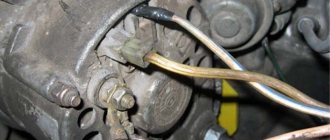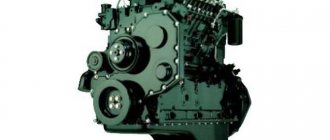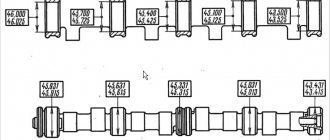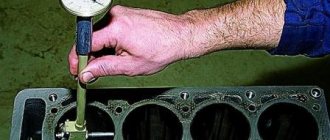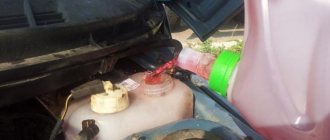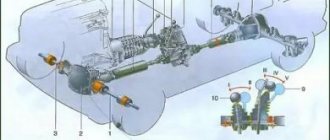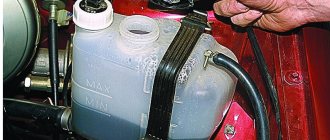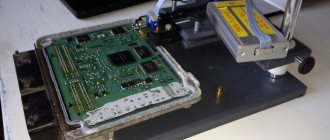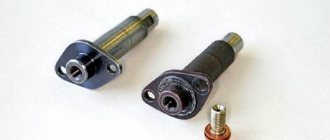Hoses for power steering Niva Chevrolet, life
set of 3 hoses
The power steering system consists of 4 hoses. One high pressure with a valve in the middle (pump-steering machine) and 3 low pressure hoses. In the designer's fields, the radiator was completely excluded from the system, so there are only two low-pressure hoses. The pressure in the “main” hose reaches several tens of kg, but there is almost no pressure in the “secondary” hoses. The plant, with the tenacity of maniacs, installs rough, thick-walled high-pressure hoses. Their disadvantage is that they cannot normally be compressed even with threaded clamps, especially in cold conditions. So their wet appearance is normal. The recommendation is simple, along with replacing the fluid and flushing the system - replace the Chevrolet Niva power steering hoses with modern and high-quality ones. Since I don’t really like stepping on rakes, I consulted with a hydraulic engineer on this topic. He “gave me” a Taiwanese hose manufacturer. The working pressure of the hoses is 250PSI (approximately 17 atmospheres). For general technical development, let me remind you that PSI is pounds per square inch. The hoses are two-layer. The internal part is MBS (oil and petrol resistant), the external part maintains external temperatures. Based on many years of installation experience on different machines, I can say the following. No cracks have ever been noticed in any climate. The most I have noticed is fading after a couple of years of use in hot climates, but as you know, this does not affect the speed. I added a couple of centimeters to the length of the hoses so that they would not rub against the air filter housing, as often happens in the factory version. For the Niva, the price list will include an option of two hoses.
Brake fluid Niva Chevrolet, gourmet
In 2021, I began to work very closely with the trendsetter in brakes, the Italian concern Brembo. I was sent a dealer catalog and in the service section I found brake fluid. The jar contains the company logo, the inscription “made in Italy”, and product characteristics. A technician confirmed that this product is made in-house. The price is a little more expensive than competitors, but it's worth it. Kinematic viscosity (pumpability) at minus 40 is 1400 cCt (DOT-4 – 1800), which allows it to be classified as DOT-4+ and used in cold climates.
Replacing steering fluid
Any vehicle periodically requires repair and maintenance, and the steering also needs to be maintained in good technical condition. In order for the hydraulic booster to work longer, the fluid in the mechanism must be changed in a timely manner; usually the replacement is done once every two years. Similar work is also performed if:
- the liquid has darkened, dirt, various impurities are found in it, or there is a burning smell;
- the car was purchased recently, and it is not known what is in the power steering reservoir;
- The power steering hummed, there is an assumption that after the fluid is replaced, the hum will disappear.
It is not difficult to change the fluid in the steering hydraulic system; we carry out the work in the following order (using the example of the Hyundai Getz):
- turn off the engine, open the hood;
- jack up the front of the car, hang it on trestles so that the front wheels can rotate freely;
- Unscrew the cap at the power steering reservoir;
- We prepare a container for waste (a plastic bottle), take a syringe, and use it to pump out the contents of the tank;
- Use pliers to loosen the clamp, then pull off the return hose;
- we make a homemade plug (it can be made from a piece of an old hose and an unnecessary candle), attach this device to the fitting;
- we lower the end of the removed pipe from the power steering reservoir into a plastic bottle, and then the work needs to be done together - one person holds the container, the second rotates the steering wheel to the right and left, briefly holding it in the extreme positions;
- liquid from the system will begin to be pumped into the bottle; approximately 0.5 liters should come out of the steering;
- then you can flush the system - pour about 0.2 liters of fresh liquid into the tank, repeat the whole operation again;
- after washing, remove the plug, replace the pipe, and secure the clamp;
- we fill the system with new fluid, while simultaneously rotating the steering wheel, also holding it for several seconds in extreme positions;
- after air bubbles stop coming out of the tank, the operation can be considered complete. All the air must be expelled, otherwise after starting the engine the liquid will foam and the power steering pump will hum.
There is no need to start the engine while bleeding air, but add enough new fluid so that it is at a level between the MIN and MAX marks. Typically, for refueling including flushing on a Hyundai Getz car, no more than 1 liter of liquid is required; at the end of the operation, we lower the front wheels into place, and after starting the engine, we top up the system, if necessary.
The process of changing the oil in the power steering
Replacing power steering fluid in a Chevrolet Niva is carried out in the following ways:
- partial oil change;
- Complete replacement of power steering fluid.
The replacement method is determined depending on the initial state of the liquid in the tank.
In order to partially change the fluid, you will need a syringe, a rubber tube, and 1.5 - 2 liters of oil.
The procedure for partially replacing the fluid in the power steering:
- Unscrew the valve of the power steering plastic expansion tank;
- Draw out the liquid using a syringe and tube;
- Fill in new fluid to the maximum mark;
- Start the engine and turn the steering wheel several times until it stops;
- Stop the engine, pump out the oil and fill in new oil.
The procedure is repeated until the solution that flows out is clean.
Filling volumes for a VAZ 21214 car
It’s one thing to buy a car, and another to know and understand what to do with it: what to protect it from, when to “feed” it, how to operate it. No matter what kind of car you own, sooner or later you will need to refuel it. Today we will talk about the filling volumes of the VAZ 21214 and what to fill where.
First of all, let's talk about the fuel tank . Its volume in the VAZ 21214 is 42 liters (including reserve). Fill with gasoline with an octane rating of 91 to 93.
The fuel supply system is necessary to power the car engine, as well as its cleaning and storage.
The volume of the cooling system is 10.7 liters , which also includes the interior heating system. Fill in coolant whose freezing point is not higher than minus 40°C.
Cooling system - devices that provide supply of cooling medium to heated engine parts and removal of excess heat, i.e. maintaining the engine within the required thermal limits.
Engine lubrication system - 3.75 liters . It is necessary to select a specific oil, depending on the ambient temperature.
-20°С +40°С SAE 15W-40
-25°С +45°С SAE 10W-40
-30°С +45°С SAE 5W-40
-25°С +35°С SAE 10W-30
-30°С +35°С SAE 5W-30
The main task of the lubrication system is to reduce friction of mating parts. It also provides cooling of engine parts, protection against corrosion, removal of wear products and carbon deposits.
The filling volume of the gearbox housing is 1.35 liters. , transfer case housing 0.75 l. , front axle housing 1.15 l. and rear axle housing 1.3 l . To fill these units, gear oils with a quality level corresponding to API GL-5 and a viscosity of 75W-90 are suitable.
Do-it-yourself replacement or car service?
Both options exist. There is nothing difficult in the process of changing engine oil yourself, of course, if you have the appropriate place to carry out this manipulation (this could be an overpass or a lift in the garage).
If this is not possible, then the operation can be performed at a car service station. The procedure is simple and does not cost a lot of money. The only point is to do the specified procedure in a trusted place. Because there are situations when dubious services partially drained the used oil, added some new oil, and that’s it.
These cases are rare, but they do occur, therefore, you should not completely exclude them; if possible, you can attend the oil change procedure to remove such a risk.
Power unit
The engine installed on the modern model of the Niva 21213 (214) car was inherited from its Soviet progenitor - the VAZ 2121, and in terms of fluid volumes they are almost identical:
- Liquid cooling system. Filled with antifreeze in an amount of 10.7 liters with a freezing point not higher than -40 ° C. The capacity of the interior heating radiator is also included in this volume.
- Crankcase. Motor oils are poured here, the brand of which depends on the operating conditions. Capacity: 3.75 liters, including oil filter filling.
The viscosity of the oil poured into the Niva engine must correspond to the outdoor temperature at which the car is operated. Possible modes and suitable oil brands are shown in the table:
| Lower limit of ambient temperature, °C | -20 | -25 | -25 | -30 | -30 | -15 | -35 | -30 |
| Upper limit of ambient temperature, °C | +45 | +35 | +45 | +35 | +45 | +45 | +25 | 30 |
| SAE lubricant viscosity grade | 15W-40 | 10W-30 | 10W-40 | 5W-30 | 5W-40 | 20W-40 | 0W-30 | 0W-40 |
When flushing the power unit during the process of replacing liquid lubricant, the same amount of flushing oil (3.75 l) is used, taking into account the size of the filter. Replacement is carried out after 8-12 thousand kilometers, depending on the quality of the oil. Flushing is usually performed after 3 engine lubricant changes. During operation, it is important to monitor the oil level in the engine crankcase using a special dipstick. If the level drops below the Min mark, it is urgent to add lubricant to the engine of the same viscosity as was previously filled.
Changing the power steering fluid in a Niva Chevrolet
At the moment, almost all modern car models are equipped with power steering. It allows you to simplify wheelbase control and make it easier. This is especially true for a car like the Chevrolet Niva, which belongs to the SUV class. The Niva's mass is one and a half tons, and in off-road conditions it is required that the wheels react sharply to turning the steering wheel. In such conditions, there is an increased load on the steering, which is fraught with breakdowns, which may result in a leak. If the level in the expansion tank drops at the slightest level, you must immediately add fluid to the Niva Chevrolet. You can do this yourself, without visiting a service station.
Also, the need to add fluid to the steering wheel on a Chevrolet Niva can be determined by its external condition. It is believed that the power steering is refilled once by the manufacturer and does not require replacement during further operation. But if there is damage to the steering rack, oil and dirt may enter the system. As a result, traces of contamination can be seen in the expansion tank. Also, power steering fluid, like all fractional mixtures, can form a sediment of components over time, which affects its quality and requires replacement. In practice, it is necessary to change it every six years, regardless of its condition, since the temperature difference between winter and summer negatively affects its condition.
Types of liquid used
The main types of liquids that are recommended for use in the Niva are Shell Donax and Ravenol Dextron II D. Previously, to determine what was filled at the factory, the markings “*” were applied to the tank to indicate Shell products and “R” for Ravenol. Recently, the manufacturer has been abandoning such labels, so it is necessary to identify the brand by color.
To replace, the bracket bolt is unscrewed. After which it becomes possible to remove the tank plug.
The tank can be removed from the bracket to drain the liquid into a specially prepared container. After this, you can loosen the clamp of a suitable hose to remove the tank.
To prevent liquid from flowing out, it is necessary to close the hole in the tank fitting, after which you need to lower the end of the hose to drain it into a container to drain the liquid. Then you need to start the engine and turn the steering wheel in different directions 3-4 times until it stops. The old fluid will gradually leave and new fluid will need to be added at the same time. The operation must be repeated until a new one begins to emerge from the outlet hose. The tank is installed in the reverse order. The fluid should be at the top level of the dipstick.
Bleeding the power steering system
To bleed the power steering system on a Niva, you need to set the steering wheel to the middle position and start the engine for a few seconds without turning the steering wheel. After this, you need to turn off the car and turn the steering wheel all the way in any direction.
Then the protective cap is removed from the special valve and, using a wrench, it is turned to bleed any remaining air from the system.
Then you need to turn the steering wheel in the other direction, leaving the air bleed valve open. An air plug and some liquid will come out of it, after which the valve must be closed. If necessary, the mixture is added to the power steering to the maximum mark. Then you need to start the engine and turn the wheel from side to side until it stops. This must be done until air bubbles stop escaping into the tank. If necessary, the mixture is topped up again to the required level.
expertniva.ru
Niva 21214: technical specifications
Kia Rio fuel tank capacity
BODY
- Body type station wagon
- Number of seats 4
- Number of doors 3
ENGINE
- Engine type four-cylinder, in-line, four-stroke
- Engine capacity, cubic meters cm 1690
- Power, hp/rpm 80/5200
- Torque, Nm/rpm 127.5/5200
- Ignition system ECM - electronic engine management system
- Valves per cylinder: 2
- Valve and camshaft arrangement overhead valve with overhead camshaft
- Engine location front, longitudinal
- Power supply system: distributed fuel injection
DRIVE UNIT
- Drive type: permanent all-wheel drive
- (there is a center differential lock)
- checkpoint
- Mechanical 5
- (plus reduction gear)
SUSPENSION
- Front independent double wishbone
- Rear dependent
BRAKES
- Front disc
- Rear drums
SPEED
- Maximum speed, km/h 142
- Acceleration to 100 km/h, from 17
FUEL
- Fuel type gasoline AI-95
- Consumption, l per 100 km
- (with mixed cycle) 10.8
DIMENSIONS
- Length, mm 3740
- Width, mm 1680
- Height, mm 1640
- Wheelbase, mm 2200
- Front wheel track, mm 1430
- Rear wheel track, mm 1400
- Ground clearance, mm
- (for tires 6.95-16 with a static radius of 322 mm.) 220
- Curb weight, kg 1210
- Permitted maximum weight (RMM), kg 1610
- Trunk volume, l in standard rear seat position 285
- with rear seat fully folded 585
- Fuel tank volume, l 42
Engine
The power unit was left virtually unchanged - it is still the same 1.7-liter engine with distributed fuel injection, meeting the Euro-4 toxicity standard. The changes include the installation of more modern and reliable sealing materials with a silicone bead, a new type of water pump oil seal, as well as a new fuel supply system with quick-release connections. All engine characteristics also remain the same.
Transmission
The transmission has been modernized much more seriously. First of all, a new clutch from Valeo was installed - the same one that is installed on the NIVA-Chevrolet. As a result of this, the resource of this unit almost doubled, and the Niva 21214m car itself became less susceptible to vibration due to a reinforced damper spring and an enlarged disk.
A more efficient crankcase ventilation system was installed on the transfer case, the cardboard seals were replaced with silicone ones, and they began to be equipped with new seals.
Due to the fact that more stringent requirements are now applied to the production of cardan shafts, which primarily relate to balancing accuracy, their service life has increased, and noise and vibration have decreased by approximately 80%.
Suspension and chassis
The most significant changes affected the suspension - it was optimized and almost completely unified with the well-proven NIVA-Chevrolet suspension:
- New front suspension steering knuckles;
- The front suspension has lower control arms with modern silent blocks;
- Front wheel alignment angles have been changed;
- Front axle of increased diameter;
- Reinforced brackets;
- New ball joints with an increased swing angle, forged body and liner made of polymer materials;
- Modern gas-oil shock absorbers with increased travel and service life;
- Optimized layout of the lower rods and arms in the rear suspension.
Brake and steering systems
For driver convenience and load reduction, the designers installed a more efficient vacuum brake booster with a more efficient brake cylinder from Lada Kalina, and new TIIR240 brake pads. Power steering is now included as standard.
Interior and exterior
Niva-21214 received a new dashboard from the Samara family, improved sidelights, improved rear-view mirrors with anti-glare coating, daytime running lights integrated into the low beam system, higher quality upholstery, as well as ISOFEX mounts for child seats.
Liquid composition
Based on the composition of the power steering fluid, it can be divided into mineral, semi-synthetic and synthetic. The chemical composition determines the basic set of oil functions:
- Viscosity characteristics;
- Lubricating properties;
- Protection of parts from corrosion;
- Prevents foaming;
- Temperature and hydraulic properties.
Synthetics and mineral water cannot be mixed with each other, since the types of additives in them have fundamental differences.
Synthetics
These are high-tech liquids, in the production of which the most modern developments and additives are used. Oil fractions for synthetics are purified by hydrocracking. Polyesters, polyhydric alcohols and sets of additives give them outstanding characteristics: a wide range of operating temperatures, stable oil film, long service life.
Semi-synthetics
A mixture of synthetic and mineral oils, due to which the latter receive significant improvements in performance: reduced foaming, fluidity, heat dissipation.
Mineralka
Mineral-based oils contain petroleum fractions (85-98%), the rest are additives that improve the performance of the hydraulic fluid.
They are used in hydraulic boosters containing seals and parts based on ordinary rubber, since the mineral component is neutral and is not harmful to rubber products, unlike synthetics.
How to properly replace coolant?
On a Chevrolet Niva, replacing the coolant must be carried out in compliance with safety precautions and the availability of tools. It is forbidden to change the coolant while the engine is hot; you must wait until it cools down. Antifreeze is a toxic mixture, so you need to be careful when working with it. Do not touch it with your hands or allow it to come into contact with unprotected skin, and under no circumstances should you suck it into your mouth.
It is necessary to change consumables away from children and animals, in a well-ventilated area. When starting the engine, the expansion tank plug must be tightened tightly. The process of replacing the refrigerant should be carried out wearing rubber gloves, special clothing and safety glasses to avoid contact with skin and eyes. If it gets on any part of the body, wash it well with water and soap.
Preparation for replacing the coolant in a Chevrolet Niva begins with placing the car on a horizontal surface. To carry out the work, you need to prepare the following list of tools:
- Key to 13;
- Container for waste mixture, volume 10 liters;
- New solution;
- Clean rag;
- Rubber gloves and safety glasses.
Having prepared everything for changing the refrigerant, you can begin to drain the coolant.
Stage one
For convenient work, it is necessary to install the machine on a level surface. The refrigerant is drained in the following sequence:
- Turn off the engine and wait for it to cool.
- Remove the cap from the radiator.
- Place a container for the used mixture under the radiator.
- Relieve excess pressure by slowly unscrewing the expansion tank cap.
- You can drain the antifreeze from the radiator through the drain valve or by disconnecting the lower pipe.
- After unscrewing the drain plug of the cylinder block, wait until the antifreeze is completely drained.
The state of the spent mixture determines the degree of its contamination. If necessary, flush the entire cooling system.
Stage two
After inspecting the old solution and making sure it is dirty, or due to switching to another type of antifreeze, you need to rinse it. To do this, you need to purchase a special washing mixture and distilled water in advance. Pour the mixture and 4 liters of water into the system. Let the engine run until the fan turns on, then drain everything. The procedure must be performed several times until the washing solution flows out clean.
Professional opinions on power steering oil
1. Is it true that synthetic oils wear out the rubber components of the power steering faster than mineral fluids?
Actually this is not true.
I have been working in a car service center for more than 13 years, many motorists claim that they buy mineral-based lubricant for power steering, since synthetic oil has a negative effect on rubber elements. Over the entire period of work, I realized that there is no connection between the type of lubricant and the rate of wear of rubber parts.
Synthetic and mineral lubricants contain additives to protect rubber gaskets and increase service life.
The main thing is that the lubricant is not dirty, otherwise the system will quickly fail, no matter whether synthetic or mineral oil is filled:
You cannot buy low-quality, cheap oil that does not meet the standard requirements. This lubricant quickly becomes dirty and does not have anti-corrosion properties, so metal parts rust and wear out. It is clear that rubber elements also fail. New oil should be added regularly to the hydraulic booster.
The lubricant contains contaminants that have a detrimental effect on rubber components. If you mixed different types of lubricant, it is important to fill the power steering with new oil as soon as possible.
2. When should you change the power steering oil?
It is necessary to fill in new oil into the hydraulic booster every 40,000–100,000 kilometers.
It is also important to consider the operating conditions of the vehicle. If you drive in severe conditions, replacement should be done every 20,000–30,000 kilometers
When the car is constantly loaded, new grease needs to be added to the power steering after 8,000–10,000 kilometers.
To increase the service life of the hydraulic booster, you must adhere to certain rules.
Every 1 thousand
km, it is important to check the smell and color of the lubricant located in the power steering expansion tank. We noticed that the lubricant has become dark and smells like burning, then you need to fill in new fluid as soon as possible
Such symptoms indicate that the elements of the mechanism are wearing out.
When the oil does not smell like burning and is dark, it can be replaced after a while. However, it is recommended to add some new lubricant. If the smell and color of the liquid are normal, it means that the system is in optimal condition and is not overloaded.
3. Signs of power steering fluid leakage
It is easy to determine that there is a power steering lubricant leak. If the first signs of an oil leak appear, you should add fluid. How to tell if oil is leaking:
- the lubricant level in the power steering expansion tank has decreased;
- there are oil stains on the steering rack, as well as under the rubber seals and on the oil seals;
- while driving the car, knocking noises appeared in the steering wheel;
- the steering wheel turns with great effort;
- The power steering pump is noisy;
- there is play in the steering wheel.
If you notice one of the symptoms described above, you should check the oil level in the tank. If necessary, add or replace lubricant. The main thing is to choose the right power steering oil.
It is prohibited to drive a car if there is not enough lubrication in the hydraulic booster, as this will lead to breakdown of the car or an accident.
Motor oils
| Oil brand | SAE viscosity grade | Group | Manufacturer | Regulatory document | |
| AAI | AP1 | ||||
| LUKOIL LUX | 5W-30, 5W-40 10W-40,15W-40 | B5/D3 | SJ/CF | LLC "Lukoil-Permnefteorg-sintez", Perm | STO 00044434-003 |
| LUKOIL LUX | 0W-40, 5W-20, 5W-30, 5W-50, 10W-30 | B5/D3 | SL/CF | LLC "Lukoil-Permnefteorg-sintez", Perm | STO 00044434-003 |
| TNK SUPER | 5W-30, 5W-40 10W-40 | B5/D3 | SJ/SL/CF | TNK Lubricants LLC, Ryazan | TU 0253-008-44918199 |
| TNK MAGNUM | 5W-30, 5W-40 10W-40,15W-40 | B5/D3 | SJ/SL/CF | TNK Lubricants LLC, Ryazan | TU 0253-025-44918199 |
| ROSNEFT MAXIMUM | 5W-40, 10W-40 | B5/D3 | SL/CF | OJSC "Novokuibyshevsk Oil and Additives Plant", Novokuibyshevsk | TU 0253-063-48120848 |
| ROSNEFT OPTIMUM | 10W-30, 10W-40 15W-40 | B5/D3 | SJ/CF | OJSC "Novokuibyshevsk Oil and Additives Plant", Novokuibyshevsk | TU 0253-062-48120848 |
| ROSNEFT MAXIMUM | 5W-40, 10W-40 | B5/D3 | SL/CF | OJSC "Angarsk Petrochemical Company", Angarsk | TU 0253-391-05742746 |
| ROSNEFT OPTIMUM | 10W-30, 10W-40 15W-40 | B5/D3 | SJ/CF | OJSC "Angarsk Petrochemical Company", Angarsk | TU 0253-389-05742746 |
| ROSNEFT PREMIUM | 0W-40, 5W-40 5W-40 | B5/D3 | SJ/CF SL/CF SM/CF | OJSC "Angarsk Petrochemical Company", Angarsk | TU 0253-390-05742746 |
Continuation of the table. 2
| Oil brand | SAE viscosity grade | Group | Manufacturer | Regulatory document | |
| AAI | API | ||||
| EXTRA 1 EXTRA 5 EXTRA 7 | 5W-30 15W-40 20W-50 | B5/D3 | SJ/CF | OJSC "Omsk Oil Refinery", Omsk | TU 38.301-19-137 |
| EXTRA | 5W-30, 10W-40, 15W-40 | B5/D3 | SL/CF | OJSC "Omsk Oil Refinery", Omsk | TU 38.301-19-137 |
| ESSO ULTRA | 10W-40 | B5/D3 | SJ/SL/CF | Exxon-Mobil, Germany | |
| GTTURBO SM | 10W-40 | B5 | S.M. | Hanval INC, Korea | |
| LIQUI MOLY OPTIMAL | 10W-40 | B5/D3 | SL/CF | Liqui Moly GmbH, Germany | |
| MOBIL 1 MOBIL SYNT S MOBIL SUPER S | 0W-40, 5W-50 5W-40 10W-40 | B5/D3 | SJ/SL SM/CF SJ/SL/CF | Exxon-Mobil, Germany | |
| MOBIL 1 ESP FORMULA | 5W-30 | B6/D3 | SJ/SL SM/CF | ||
| RAVENOL HPS RAVENOL VSI RAVENOL LLO RAVENOL TSI RAVENOL Turbo-C HD-C | 5W-30 5W-40 10W-40 10W-40 15W-40 | B5/D3 | SL/CF SL/CF SL/CF SL/CF SJ/CF | Ravensberger Schmirstoffvertrieb GmbH, Germany | |
| SHELL HELIX: PLUS PLUS EXTRA ULTRA | 10W-40 5W-40 5W-40 | B5/D3 | SL/CF | SHELL EAST EUROPE Co, UK, Finland | |
| ZIC A PLUS | 5W-30, 10W-30, 10W-40 | B5 | SL | SK CORPORATION, Korea | |
Note. The oil change period is in accordance with the vehicle service book.
Table 3
| Minimum engine cold start temperature, 0C | Viscosity grade according to SAE J 300 | Maximum ambient temperature, 0C |
| below -35 | 0W-30 | 25 |
| below -35 | 0W-40 | 30 |
| -30 | 5W-30 | 25 |
| -30 | 5W-40 | 35 |
| -25 | 10W-30 | 25 |
| -25 | 10W-40 | 35 |
| -20 | 15W-40 | 45 |
| -15 | 20W-40 | 45 |
This is interesting: How many liters of oil are in a Peugeot 307 engine
Fluid replacement
If you need to change the power steering fluid for a Niva Chevrolet, you can do it as follows:
- Unscrew the coupling bolt and unscrew the cover
- The reservoir is removed from the bracket and the clamp that secures the power steering outlet hose is loosened.
To prevent liquid from flowing out during filling, you need to plug the hole in the barrel fitting, lower the outlet hose end into a container where the waste will be drained. We start the engine and begin to rotate the steering wheel, while adding new fluid and draining the old one, the steering wheel must be turned in different directions four times. After this, we install the tank in its place, reconnect all the hoses and add new fluid to the required level.
Leveling up
After replacement, bleed the system as follows:
- Set the steering wheel to the middle position
- Start the engine for 30 seconds and turn it off, without turning the steering wheel.
- When the engine is turned off, the steering wheel must be turned all the way in any direction.
- The exhaust valve has a protective cap that needs to be removed
- Turn the steering wheel all the way in the other direction, at this time air should come out through the valve, after which liquid will flow
- Close the cap back.
- Add oil, start the engine, turn the steering wheel back all the way, turn off the engine.
- Add oil to the top mark
At this point, the pumping work can be considered completed.
Main elements of the system
The largest and most basic element is the fuel tank, but the total number reaches sixteen. Their volumes vary greatly. Features of containers for refilling liquids in the Chevrolet Niva:
- they are necessarily included in the engine cooling and lubrication systems;
- Axle housings and gearboxes are also extremely important for safety during travel;
- Niva Chevrolet filling tanks include power steering systems and hydraulic brake lines, front and rear shock absorbers;
- An integral part are reservoirs for windshield washer and air conditioning.
Almost all tanks are made of plastic and stainless steel, capable of withstanding an aggressive hydrocarbon environment for a long time.
Tank characteristics
The fuel tank of this model has almost sixty liters, or more precisely - 58. On average, per hundred kilometers you have to spend 8-9 liters of AI-95, Premium-95 or AI-92 gasoline.
- The tank is located directly under the rear seat.
- In the upper part there is a small hatch under which the fuel pump is installed.
- The sensor will help determine the level of fuel fluid and the amount of gasoline.
There are other Chevrolet Niva filling tanks, many of which are included in various systems.
Fluid in Niva Chevrolet
At the moment, almost all modern car models are equipped with power steering. It allows you to simplify wheelbase control and make it easier. This is especially true for a car like the Chevrolet Niva, which belongs to the SUV class. The Niva's mass is one and a half tons, and in off-road conditions it is required that the wheels react sharply to turning the steering wheel. In such conditions, there is an increased load on the steering, which is fraught with breakdowns, which may result in a leak. If the level in the expansion tank drops at the slightest level, you must immediately add fluid to the Niva Chevrolet. You can do this yourself, without visiting a service station.
Also, the need to add fluid to the steering wheel on a Chevrolet Niva can be determined by its external condition. It is believed that the power steering is refilled once by the manufacturer and does not require replacement during further operation. But if there is damage to the steering rack, oil and dirt may enter the system. As a result, traces of contamination can be seen in the expansion tank. Also, power steering fluid, like all fractional mixtures, can form a sediment of components over time, which affects its quality and requires replacement. In practice, it is necessary to change it every six years, regardless of its condition, since the temperature difference between winter and summer negatively affects its condition.
Types of liquid used
The main types of liquids that are recommended for use in the Niva are Shell Donax and Ravenol Dextron II D. Previously, to determine what was filled at the factory, the markings “*” were applied to the tank to indicate Shell products and “R” for Ravenol. Recently, the manufacturer has been abandoning such labels, so it is necessary to identify the brand by color.
To replace, the bracket bolt is unscrewed. After which it becomes possible to remove the tank plug.
The tank can be removed from the bracket to drain the liquid into a specially prepared container. After this, you can loosen the clamp of a suitable hose to remove the tank.
To prevent liquid from flowing out, it is necessary to close the hole in the tank fitting, after which you need to lower the end of the hose to drain it into a container to drain the liquid. Then you need to start the engine and turn the steering wheel in different directions 3-4 times until it stops. The old fluid will gradually leave and new fluid will need to be added at the same time. The operation must be repeated until a new one begins to emerge from the outlet hose. The tank is installed in the reverse order. The fluid should be at the top level of the dipstick.
Bleeding the power steering system
To bleed the power steering system on a Niva, you need to set the steering wheel to the middle position and start the engine for a few seconds without turning the steering wheel. After this, you need to turn off the car and turn the steering wheel all the way in any direction.
Then the protective cap is removed from the special valve and, using a wrench, it is turned to bleed any remaining air from the system.
Then you need to turn the steering wheel in the other direction, leaving the air bleed valve open. An air plug and some liquid will come out of it, after which the valve must be closed. If necessary, the mixture is added to the power steering to the maximum mark. Then you need to start the engine and turn the wheel from side to side until it stops. This must be done until air bubbles stop escaping into the tank. If necessary, the mixture is topped up again to the required level.
Other liquids and fuels and lubricants
Every car enthusiast should know by heart the maximum fuel capacity of his car. The fuel tank of the VAZ 21213 has a capacity of 42 liters, including reserve. The reserve refers to the amount of fuel remaining in the tank after the yellow warning light on the instrument panel turns on. The reserve amount is at least 5 liters. The car must be fueled with gasoline whose octane number is in the range of 91-93.
The car has a number of refueling tanks that the owner must monitor during operation:
- brake system with expansion tank, total capacity - 0.515 l;
- hydraulic clutch drive with expansion tank - 0.2 l;
- 2 plastic tanks with a volume of 2 liters each contain a supply of windshield and rear window washer fluid.
The clutch release drive and brake system are filled with hydraulic brake fluid (the most popular is DOT-4). It should be changed at least every 3 years, because the liquid has the ability to absorb water vapor contained in the air. As a result, all steel parts of the system in contact with it begin to corrode, which leads to complete or partial failure of the brakes.
If there is a leak in the clutch or brake system, the level in the expansion tanks decreases, so constant monitoring is required over them.
The level of brake fluid in the reservoirs must be maintained no lower than the corresponding mark on the plastic body of the container.
Liquid or clean water for washing glass is added if necessary; in winter, a non-freezing option is required. Otherwise, the ice will not only destroy the tubes, but also damage the electric pump.
Various thick lubricants are also used for maintenance and lubrication of the Niva:
- Litol - a composition for lubricating highly loaded bearing parts;
- CV joints-4 - lubricant for the hinges of the front axle shafts and door opening limiters;
- ShRB-4 is designed for processing ball joints and steering rods.
The list of refueling containers is useful for novice car enthusiasts who bought a used car with a lost instruction manual. The operation of such a car should begin with the replacement of all fluids and oils.
Replacing power steering fluid on a Chevrolet Niva
Remove the protective cap from the air release valve. Unscrew the air bleed valve on the steering gear. Without turning the valve, turn the steering wheel all the way in the other direction.
There are two ways to replace the fluid in the Chevrolet Niva power steering: To partially replace the power steering oil, you will need a syringe with a tube and the oil itself, enough so that at the end of the work it will no longer be dark. Using a syringe with a tube, completely pump out the fluid from the power steering reservoir.
Fill the reservoir with new fluid to the MAX level. We start the engine and turn the steering wheel left and right to the extreme position. Drive onto an overpass, or jack up the car so as to hang the front wheels of the Chevrolet Niva, in order to be able to easily rotate them with the engine not running.
Use a syringe with a tube to remove as much old oil as possible from the tank.
Now you need to determine through which hose the oil enters the Chevrolet Niva power steering expansion tank - this is the return, and through which it leaves and goes to the power steering pump. Disconnect the hose through which the oil enters the return tank.
Now we extend this hose with our drain hose and direct it into a pre-prepared container. A prepared plug must be installed in that outlet of the power steering expansion tank. Fill with new fluid up to the MAX mark.
Without starting the engine, smoothly turn the Chevrolet steering wheel all the way left and right. At this time, old power steering oil should begin to flow out through the drain hose, and at the same time, the oil from the reservoir should go into the system. We repeat this until light oil flows from the drain hose into the container.
Now, to clean the power steering pump, start the engine for a second.
At this moment, you must not allow the power steering oil to completely drain from the reservoir into the system and allow air to be sucked in!
Replacing fluid in the power steering hydraulic system of Niva Chevrolet
Replace the fluid in the power steering system if it is excessively dirty.
The manufacturer does not give clear recommendations on the frequency of replacing fluid in the hydraulic system, so we recommend replacing it after six years, regardless of its condition.
For use in the hydraulic system of the amplifier, the manufacturer recommends a fluid - Pentosin Hidraulik Fluid CHF11S oil. However, for technological reasons, on cars starting with VIN No. X9L21230040005880, the hydraulic system uses Shell Donax TA D-21631 (Dexron II), and with VIN No. X9L21230040006248 - Ravenol Dexron II D.
Cars filled with Shell Donax oil have a mark on the tank - “*”, and cars filled with Ravenol Dexron II D - “R”, but on cars of the latest production these marks may not be present.
Dexron II fluids (red) cannot be mixed with Pentosin Hidraulik Fluid CHF11S (green). It is possible to completely replace the fluid after flushing the power steering hydraulic system.
When using Dexron II fluids, reduce the period of use by half the recommended time.
| 1. Remove the coupling bolt of the power steering reservoir reservoir bracket. | 2. Unscrew the tank cap. |
| 3. Remove the reservoir from the bracket and drain the liquid from the reservoir into a suitable container. | 4. Loosen the clamp securing the outlet hose and remove the hose. |
| 5. To prevent fluid from leaking out, plug the hole in the tank fitting and lower the end of the outlet hose into a container for drained fluid. Start the engine and, turning the steering wheel from lock to lock in both directions three or four times, drain the old fluid while adding new fluid. Repeat the operation until fresh fluid appears from the outlet hose. Carefully monitor the fluid level in the reservoir and do not allow air to enter the power steering pump. This may damage the pump. 6. Install the tank in the reverse order of removal. 7. Add fluid to the level of the upper mark on the dipstick of the reservoir plug. | 8. Bleed the power steering system. |
Bleeding the power steering system
The need for bleeding arises when air enters the hydraulic system during repair work or when there is a loss of tightness during operation. A sign of air in the system is the steering wheel jamming when you try to turn it sharply. In addition, the pump makes increased noise when the steering wheel is turned, and the fluid in the reservoir usually foams.
You will need an 8 key.
1. With the steering wheel in the middle position, run the engine for 10–15 seconds.
2. Stop the engine without turning the steering wheel.
3. Turn the steering wheel all the way in one direction.
| 4. Remove the protective cap from the air release valve. | 5. Unscrew the air release valve on the steering gear. |
6. Without turning the valve, turn the steering wheel all the way in the other direction. In this case, air should come out of the valve, and then liquid.
7. Without touching the steering wheel, close the air release valve.
8. After adding oil to the tank, start the engine and turn the steering wheel in both directions until it stops, without holding it in its extreme positions. After air bubbles stop appearing in the tank, stop the engine.
9. Add fluid to the level near the top mark on the dipstick of the reservoir plug.
Signs of trapezoidal problems
Even with careful driving, the trapezoid has its resource, although Chevrolet Niva owners note that it reaches 100,000 km. In fact, the information is not entirely accurate. Every 25 - 30 thousand km, it may be necessary to replace the steering tips, and they are an integral part of the trapezoid.
The first sign of a joint failure is increased play in the steering wheel. The hinge pins wear out and need to be replaced. Recently, drivers prefer to purchase rods or ends assembled with a hinge. Lack of lubrication will accelerate wear of the moving joint. Although the manufacturer adds the required amount of lubricant to the joint, compliance with this obligation should be checked.
Three factors have been identified that lead to trapezoidal faults.
- Poor quality of road surface.
- Driving style.
- Manufacturing defects.
In any case, it is necessary to carry out repair work as quickly as possible. The condition of the steering system determines the safe operation of the vehicle. It should be noted that prolonged absence of repair will lead to complete destruction of the hinge. On the highway, the car will become uncontrollable, which can lead to an accident.
Read news about the new Niva
- Steering tips Niva Chevrolet
- What tire size is available for installation on Niva, available versions and recommendations
- Mud tires for Niva 4x4: radius 15 and 16 - which one is better to install "
- All about the Valet button and how to disable it yourself on alarm systems of different brands
- Niva Lynx buy in Samara - prices for the new Lada “Bronto” (Niva Pickup) | cost and equipment
- Air conditioning Niva Chevrolet - design and repair "
- Niva Chevrolet installation of air conditioning - Auto magazine MyDucato
- Instrument panel Niva Chevrolet designations. Improving the Chevrolet Niva dashboard
Transmission
The Niva 4x4 transmission system has the following filling volumes:
- transfer case - 0.79 l;
- gearbox - 1.6 l;
- rear axle - gearbox - 1.3 l;
- front axle - crankcase - 1.15 l;
- steering column - crankcase - 0.18-0.2 l.
As with the operation of a power unit, under different temperature conditions, transmission units and assemblies are filled with oils of different viscosities, which is reflected in the table:
| Lower limit of ambient temperature, °C | -15 | -25 | -25 | -30 | -40 |
| Upper limit of ambient temperature, °C | +45 | +45 | +35 | +45 | +35 |
| SAE lubricant viscosity grade | 85W-90 | 80W-90 | 80W-85 | 75W-90 | 75W-80 75W-85 |
As stated in the operating instructions, transmission lubricants need to be changed once every 30 thousand km. mileage At the same time, replacement is not provided for in the steering mechanism housing, only an addition through the top plug. The “native” oil for Zhiguli transmission units is considered to be TAD17I.
Transmission oils have good penetrating ability. Therefore, poorly clamped plugs and worn gaskets of units begin to gradually leak lubricant. In such situations, it is allowed to add oil of the same viscosity class and, preferably, the same manufacturer. If you do not top up during a leak, the lubricant level in the unit will decrease, which will lead to accelerated wear of expensive mechanisms.
Niva engine characteristics
Years of manufacture - (1994 - present time) Cylinder block material - cast iron Power system - carburetor (21213) / injector (21214) Type - in-line Number of cylinders - 4 Valves per cylinder - 2 Piston stroke - 80mm Cylinder diameter - 82mm Compression ratio - 9 .4 Engine capacity Niva 21213 - 1690 cm3. Engine power Niva 21213 - 81 hp. /5200 rpm Torque - 125 Nm / 3000 rpm Fuel - AI93 Fuel consumption - city 11.5l. | track 8.3 l. | mixed 10.5 l/100 km Oil consumption - 700 g per 1000 km Niva engine weight - 117 kg Overall dimensions of the Niva 21213 engine (LxWxH), mm - Oil in the Niva 21213 engine: 5W-30 5W-40 10W-40 15W-40 How much oil is in the Niva engine 21213/21214: 3.75 l. When replacing, fill in about 3.5 liters.
Niva engine life: 1. According to the plant - 80 thousand km 2. In practice - up to 150 thousand km
TUNING Potential - 200 hp. Without loss of resource - 90 hp.
The engine was installed on: VAZ 21213 “Niva”VAZ 21214 “Niva”Chevrolet Niva
Oil change intervals on Niva
The service life of the motor largely depends on proper maintenance. Compliance with lubricant change intervals is also of great importance. The frequency of the procedure largely depends on the condition of the vehicle, its operating conditions, and directly on the lubricant itself. The manufacturer recommends changing every 20 thousand km (or every twelve months). However, these figures are averages and do not take into account many aspects.
What affects the timing of the lubricant change procedure:
- Air pollution.
- The quality of the fuel being poured.
- Changes in temperature values.
- Condition of the roads.
- Travel mode. In traffic jams, the mileage does not increase, but the engine runs.
Depending on how the car is used, the need for periodic topping up of oil cannot be ruled out. This is due to the natural consumption of lubricant during operation of the power unit. It can reach up to 0.7 liters every 1000 km. High fluid consumption is one of the disadvantages of the engine of this vehicle (along with low service life, noisy operation of the unit and vibrations).
Despite the information provided by the manufacturer, the actual lubricant replacement interval is 7...10 thousand km, which is due to the engine operating under fairly significant loads.
An important aspect when preparing for a replacement is that it is important to choose correctly which oil for the Niva engine will be the best option. Any car owner must take this task responsibly if there is no desire to carry out unplanned repair work.
More on the topic: Choosing oil for BMW
Signs of trouble
On the Internet you can find many different videos and materials that discuss the issue of airing and problems in the power steering on cars of different types, classes and sizes.
Therefore, do not be surprised if you come across questions regarding power steering pumping:
- on KAMAZ;
- on Shakman;
- ZIL 130;
- on the Volga (GAZ 31105);
- in Scania;
- Toyota Corolla;
- Nissan Qashqai;
- Lada Priora;
- Renault Symbol;
- Ford Focus;
- Niva Chevrolet;
- Volkswagen Passat B3;
- Toyota Avensis;
- Skoda Octavia;
- Renault Logan, etc.
The automotive power steering system can become airy for reasons already stated, related to breakdowns, or structural interference in the power steering.
At the same time, every driver is recommended to be aware of the characteristic signs indicating the fact that the system is air-filled. It is when they appear that mandatory pumping is required.
There is nothing difficult in diagnosing and detecting the problem. Look for the appearance of one or several signs indicated in the list:
- there is a strong noise near the power steering itself;
- strong extraneous noise may come from the power steering pump;
- there is a clear increase in pressure on the steering wheel;
- the steering wheel becomes harder to turn during maneuvers;
- leakage of working fluid is observed from the system;
- foam appears on the surface in the expansion tank with hydraulic fluid;
- The steering wheel rotates spontaneously in different directions.
Bottom line
You need to change the oil, you need to do it on time and use high-quality consumables. The longevity of the engine largely depends on the issues that are associated with this important component. Don’t skimp on such little things, because a major overhaul of your car’s power unit will cost tens of times more than regularly replacing high-quality engine filler.
There are not so few links in this chain, and this always means that not everything is as simple as you would like. But statistics show, and reviews from car enthusiasts confirm, that counterfeit oil is becoming increasingly rare on store shelves, and it’s not worth chasing after saving money when shopping on spontaneous, semi-legal auto parts markets.
It is also worth paying tribute to the Chevrolet Niva model itself. The car is very unpretentious and can forgive some mistakes when it comes to changing the oil, but you should not look for the ultimate strength in this matter in your car by personal example.
